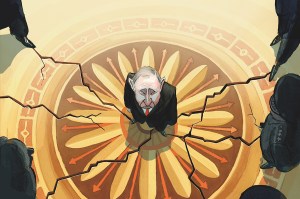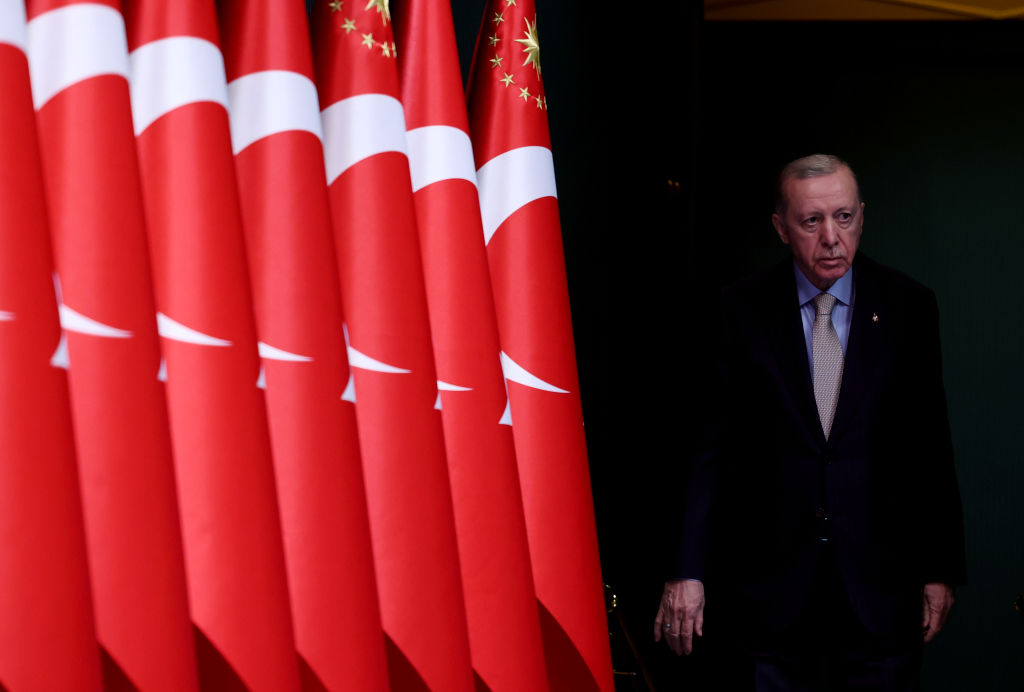History is relayed through anecdotes. And there’s one anecdote about foreign policy in particular that keeps coming back to me.
It was 2013 and President Barack Obama’s advisors were weighing what to do about Syria. Dictator Bashar al-Assad was then waging a bloody civil war against an increasingly jihadist-dominated rebellion, destabilizing the Middle East and feeding a refugee crisis. Enter that ridiculous balloon John Kerry, then the secretary of state, who at a White House principals meeting stood up and began bloviating about the need to bomb the Assad regime.
Kerry was interrupted in the midst of his JFK LARPing by General Martin Dempsey, the chairman of the Joint Chiefs of Staff. According to reporting from Bloomberg, “Dempsey informed Kerry that the Air Force could not simply drop a few bombs, or fire a few missiles, at targets inside Syria: To be safe, the U.S. would have to neutralize Syria’s integrated air-defense system, an operation that would require 700 or more sorties.” He made clear that “the State Department didn’t fully grasp the complexity of such an operation” and that Kerry’s grandiloquence “wasn’t welcome.”
“You and what army?” is what Dempsey probably wanted to tell Kerry (one imagines toffs on windsurfing boards descending on Damascus). Yet in fairness to Kerry, the mistake he made is a common one. We all like to think about foreign policy in such facile terms. Want an airstrike against Assad? Just order one up and watch it happen. The planning and expense of resources, the contingency scenarios and risks to human life, all of which factor into even the simplest of military operations, get elided over.
Now, we’re seeing this mistake again, this time over whether we should implement a no-fly zone in Ukraine. Commentators and politicians who want America to clear the Ukrainian skies can sound like they’re playing that old computer game SimCity. Just press the button for the no-fly zone and position the cursor where you like. You can even open the Disasters menu and select a Russian invasion, just to test it out.
The problem with a no-fly zone isn’t just that fighting between Russian and American jets could escalate into a nuclear holocaust (which is why even Senator Marco Rubio, usually a hawk, is against one). It’s the sheer logistical impossibility of securing tens of thousands of square miles of airspace — if not hundreds of thousands, should you decide to cover all of Ukraine — that are currently buzzing with Russian and Ukrainian ordnance. And because Vladimir Putin has long-range surface-to-air missiles, closing the skies would likely mean attacking anti-air assets in both Russia and Belarus.
That’s before you get to the realities of keeping the planes in the skies, refueling and maintaining them, as well as the difficulties of getting them there in the first place. Ukraine is half a world away from the United States; NATO has airbases across Eastern Europe, but the air forces of those nations, whose assistance would be required, are comparatively weak. America has successfully established no-fly zones in the past, in Iraq and Libya, for example, but the enemy forces there were much feebler and the airspace much less contested.
In fairness to the American foreign policy establishment, that much-maligned group of pencilheads, most of them have bowed to reality when it comes to a no-fly zone. NATO has ruled out one. The White House has downplayed even a smaller zone to protect evacuation corridors, noting that the difficulties and risks would be much the same. Still, there remain those who insist that We Must Do Something. Senators Roger Wicker and Joe Manchin have both said a no-fly zone should remain on the table, while Congressman Adam Kinzinger has outright endorsed one. An open letter encouraging Joe Biden to create one was signed by twenty-seven foreign policy experts.
Thankfully that horse’s ass John Kerry has yet to weigh in, except to fret that Russia’s slaughter of Ukrainians could distract from the far more pressing matter of protecting his Cape Cod villas against rising sea levels. Yet the mentality lives on. The conceit that America can do anything, that our immense might enables us to bend the laws of war and physics, is a dangerous one. Such hubris led us to think we could build a new nation out of scratch in Iraq. It caused us for years to ignore the reality on the ground in Afghanistan, not a stronghold of democracy but a violent klepto- and narco-state.
Now it’s blinding at least some of us to the perils in Ukraine. Tweeting solidarity is not the same as carrying out an elaborate military operation. If there is a silver lining to this horrific crisis, perhaps it’s that it’s forced us to live in the real world once again.

























